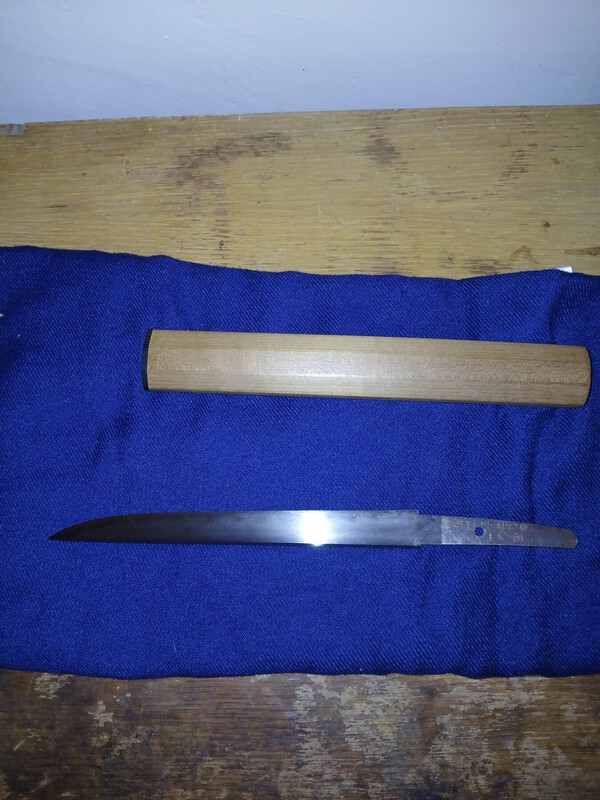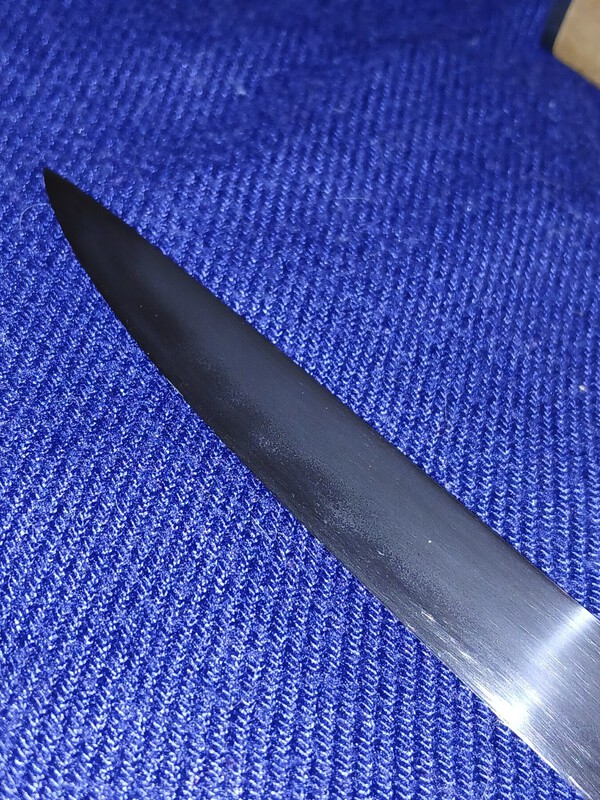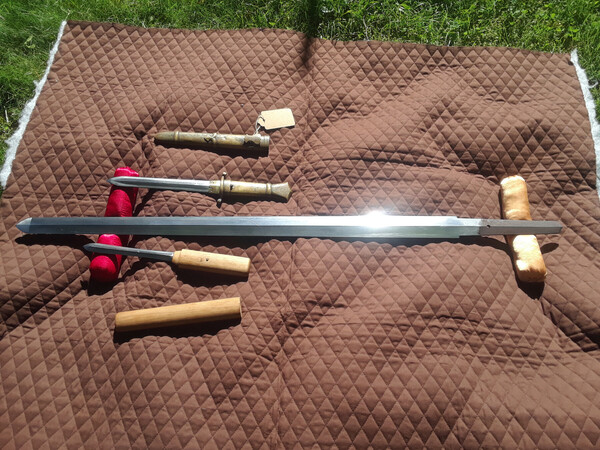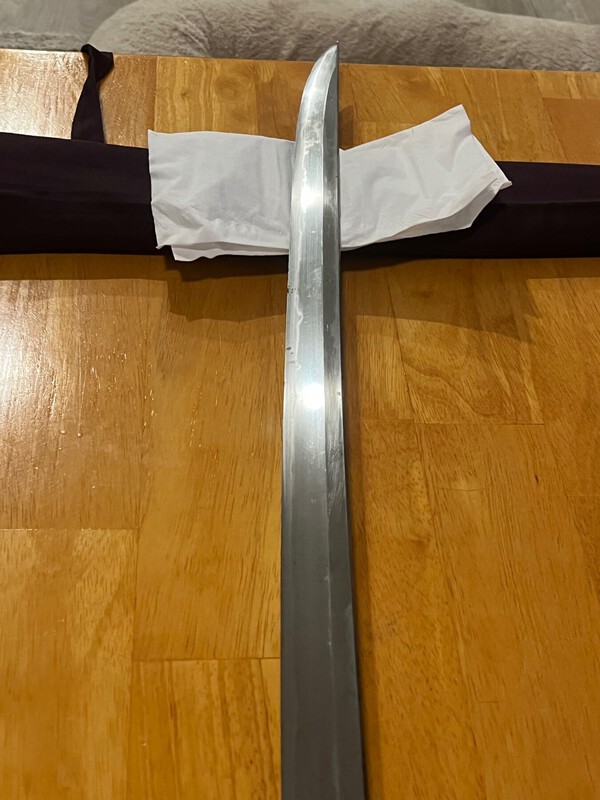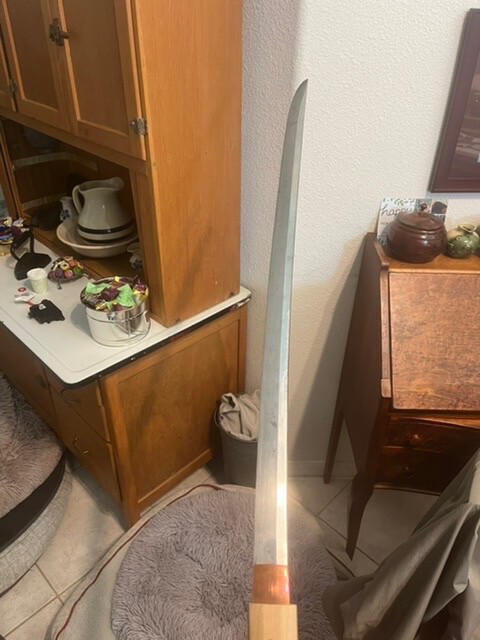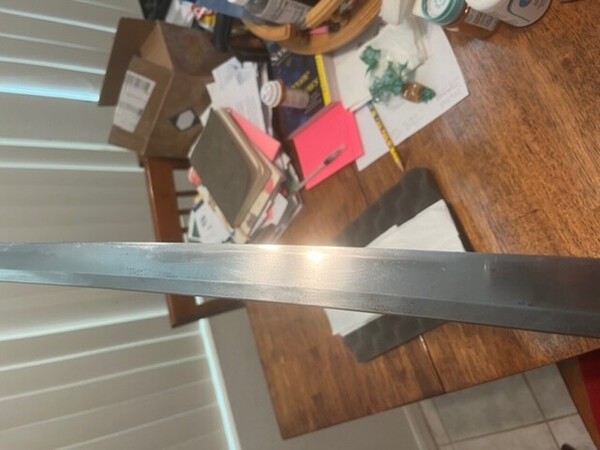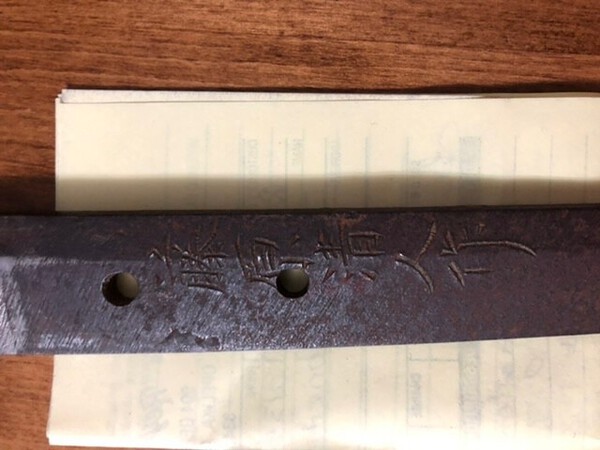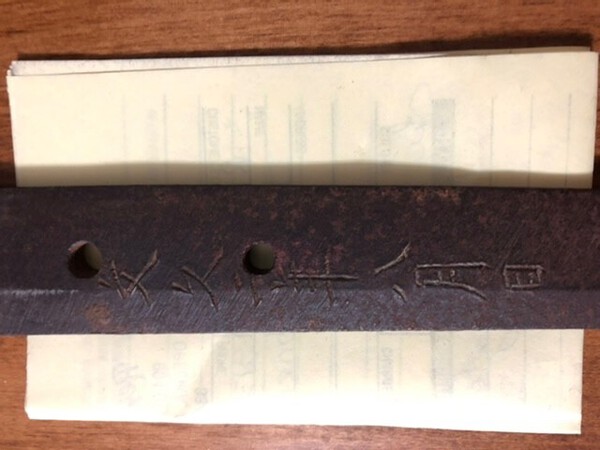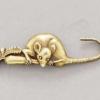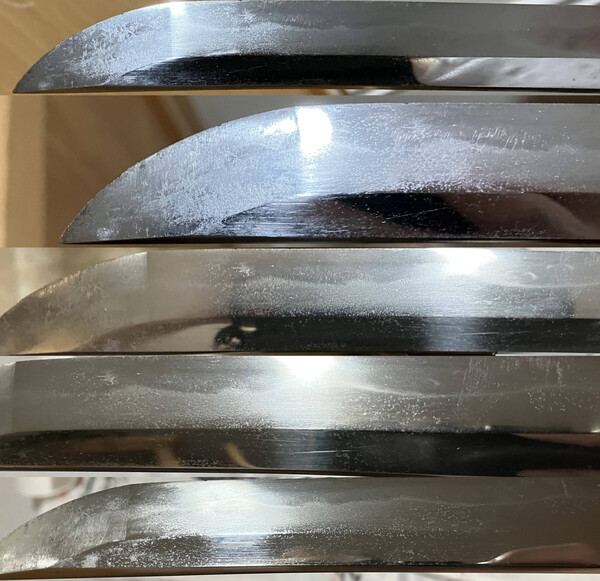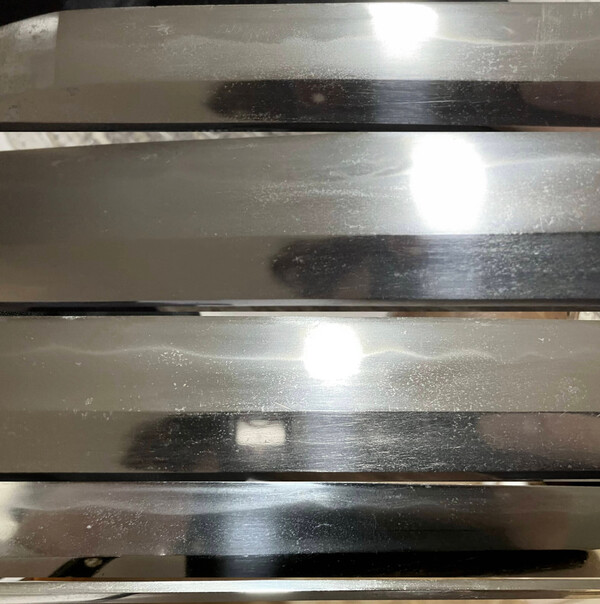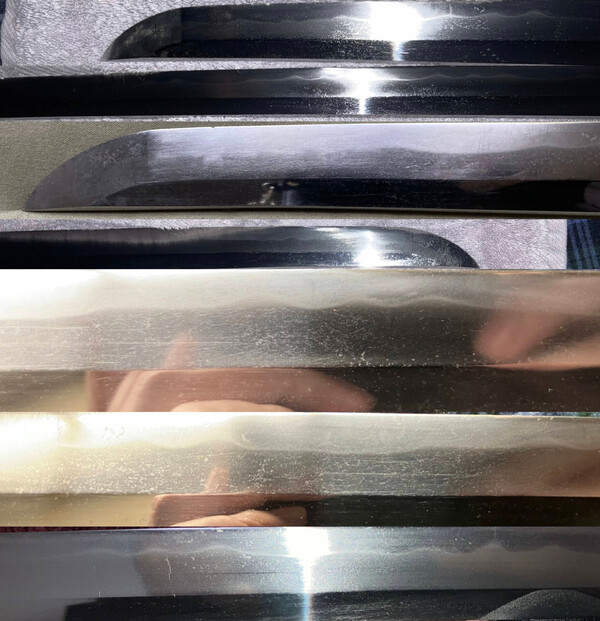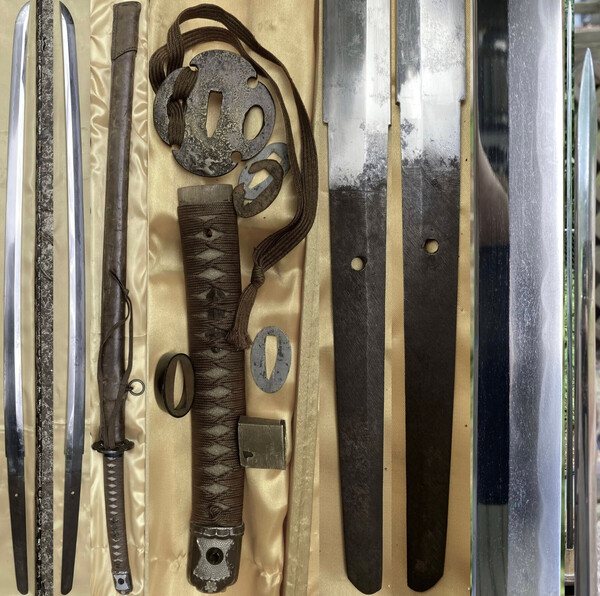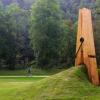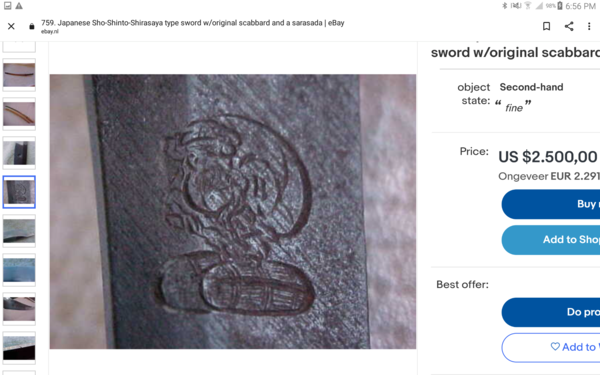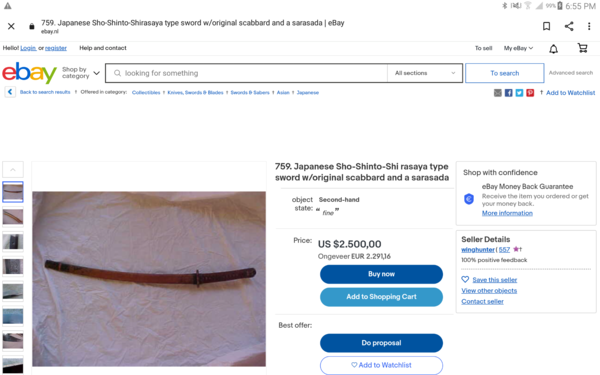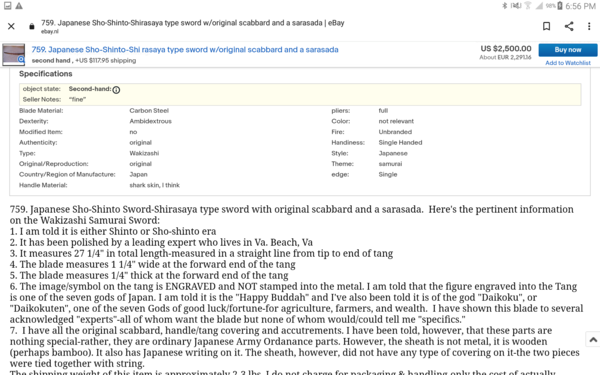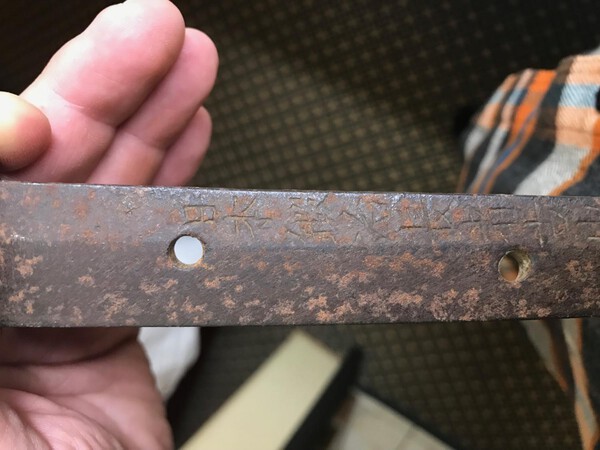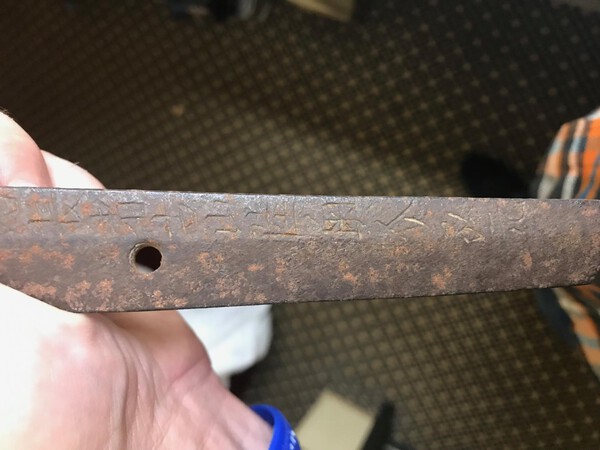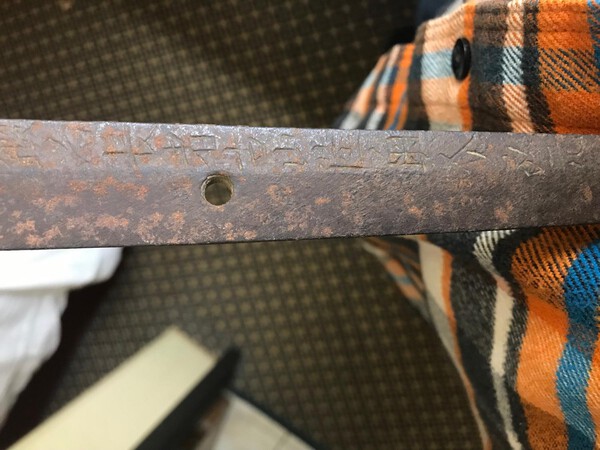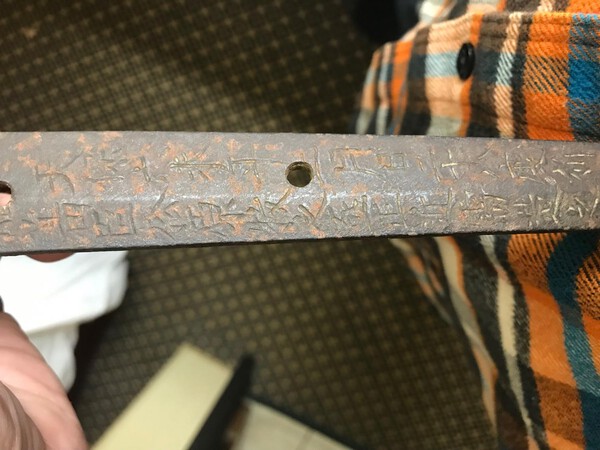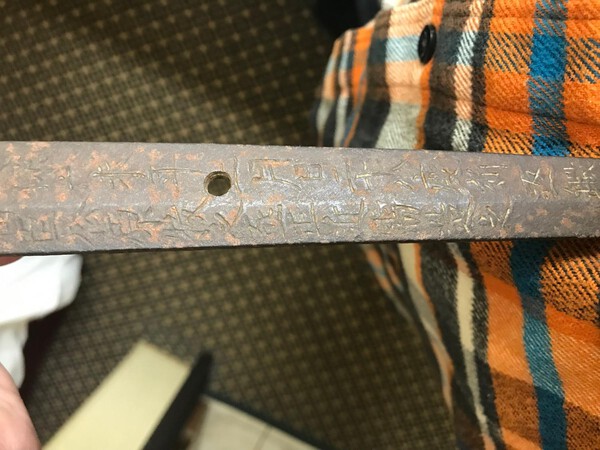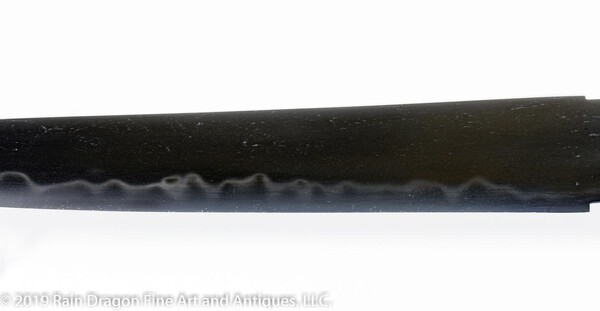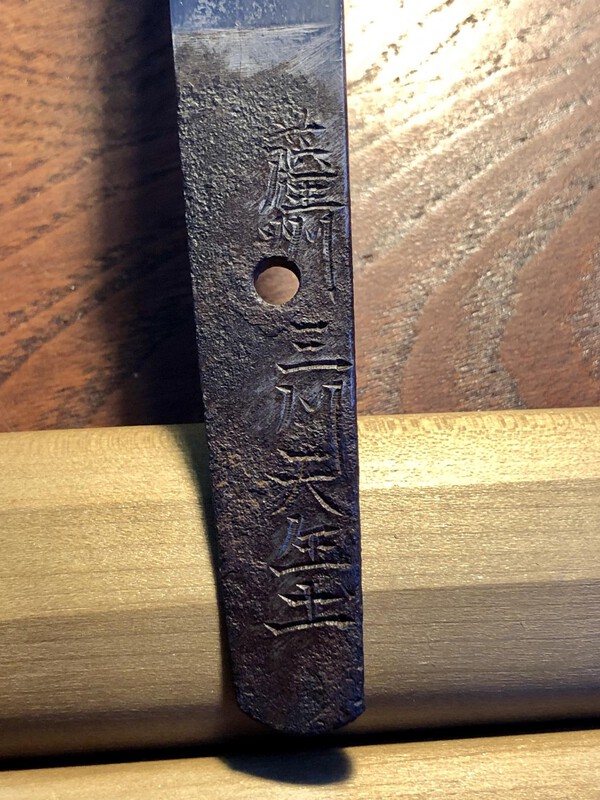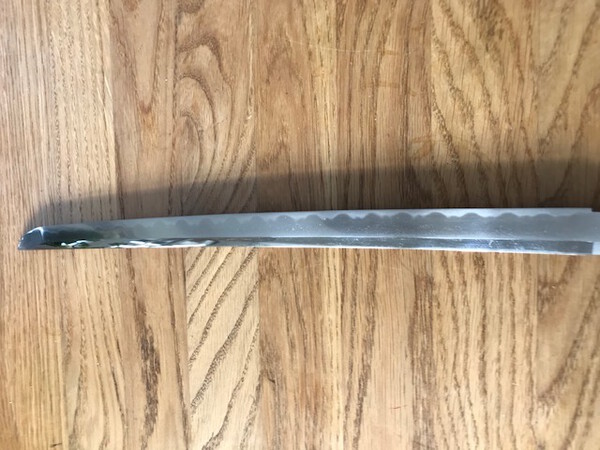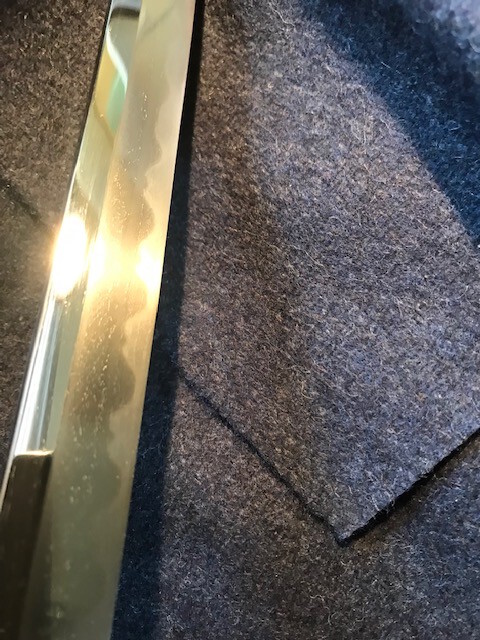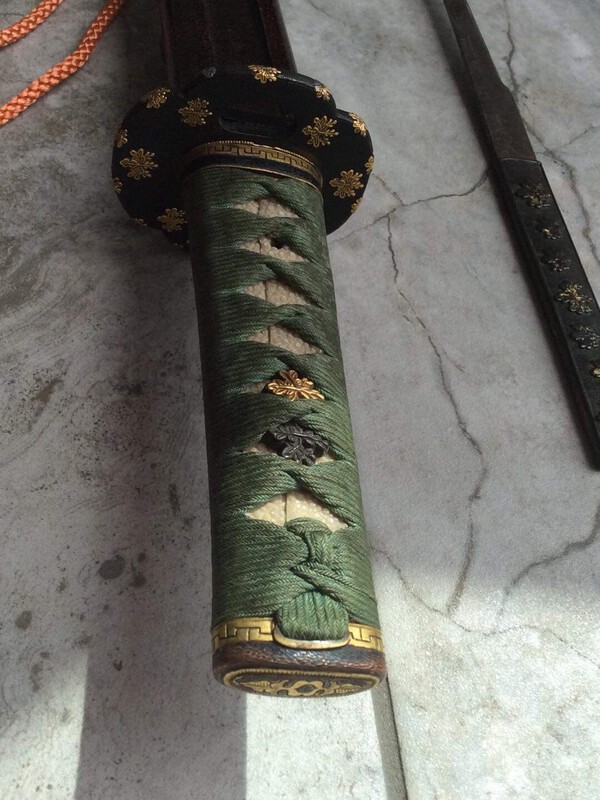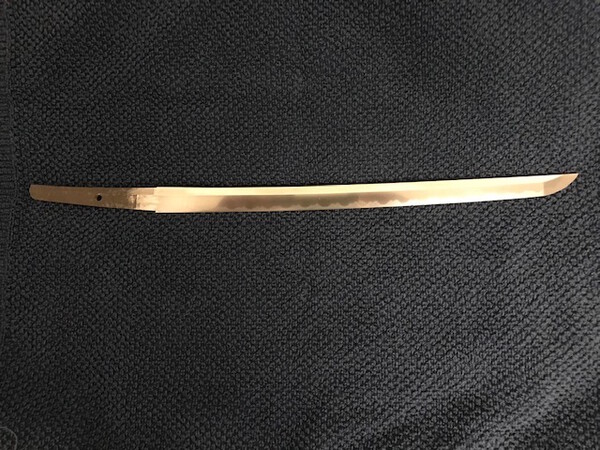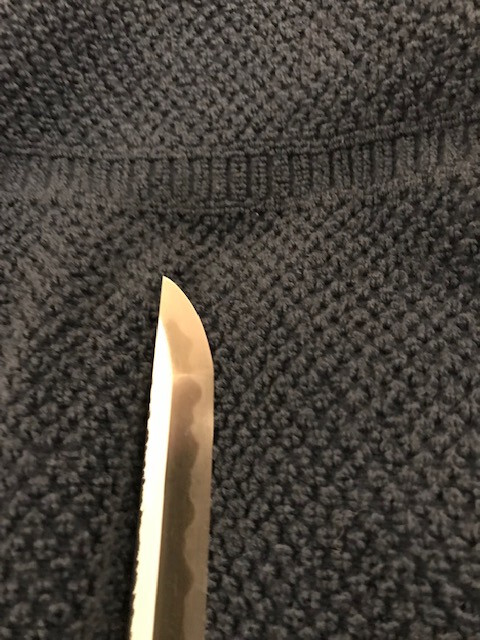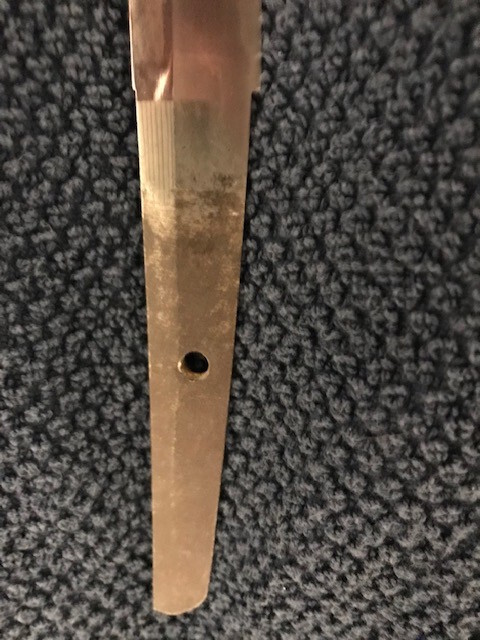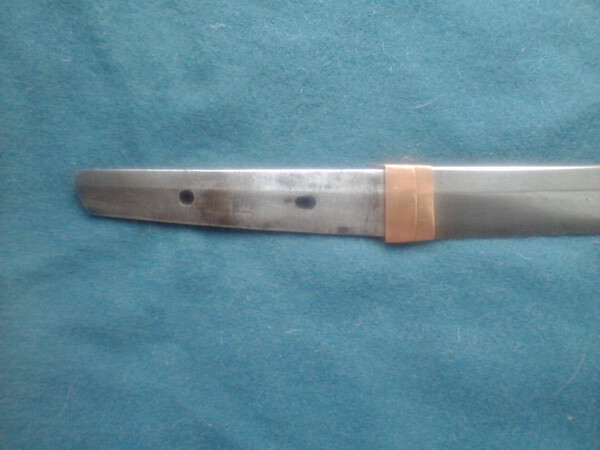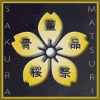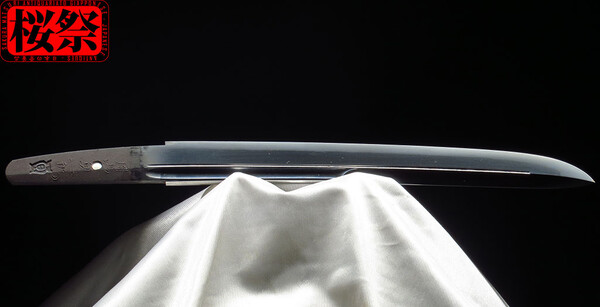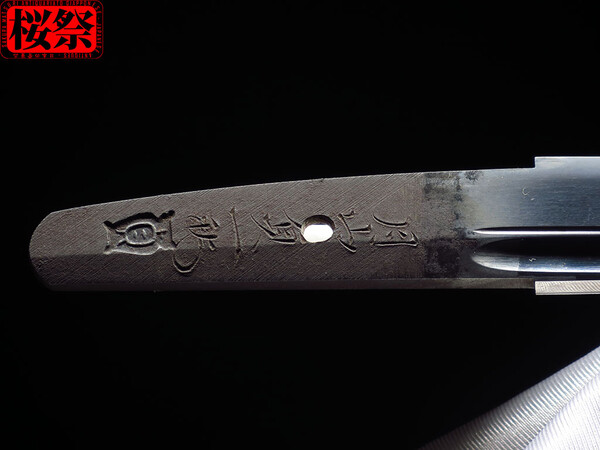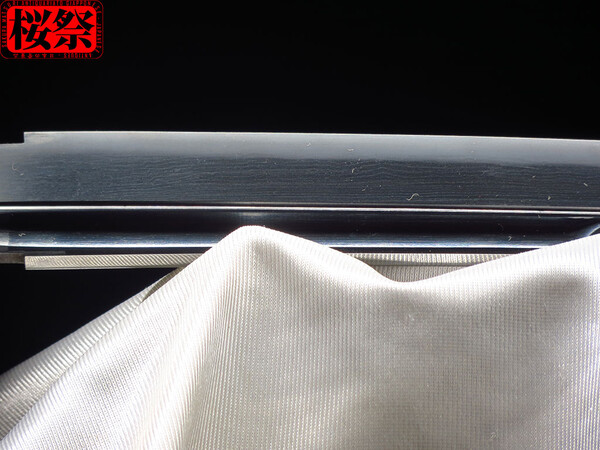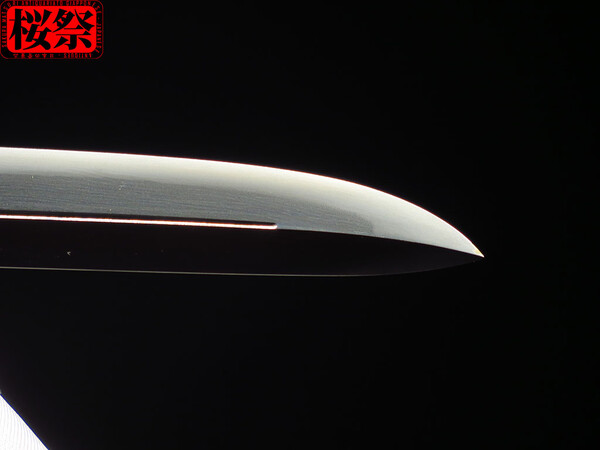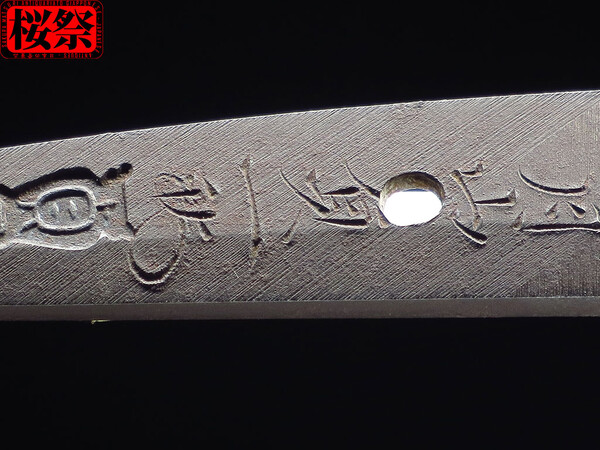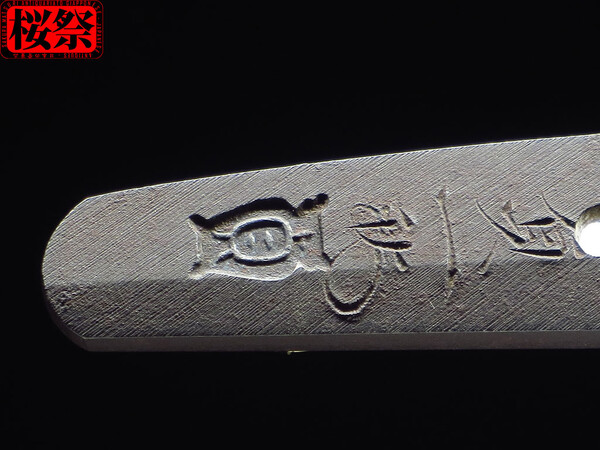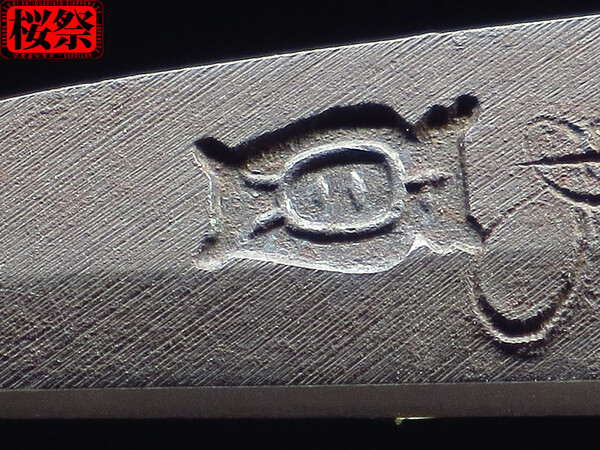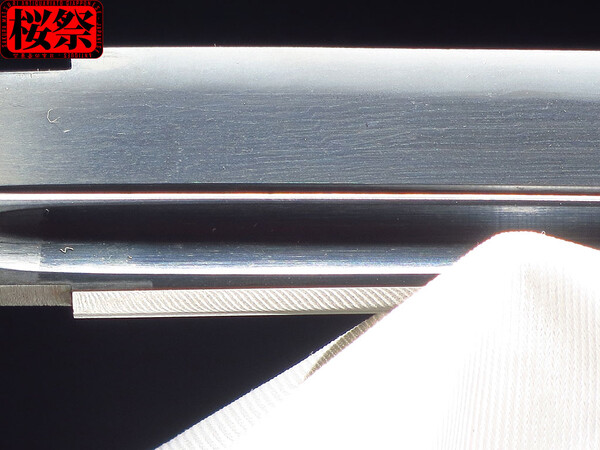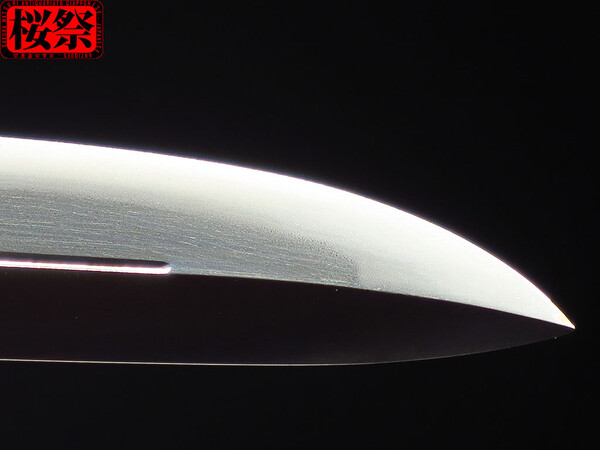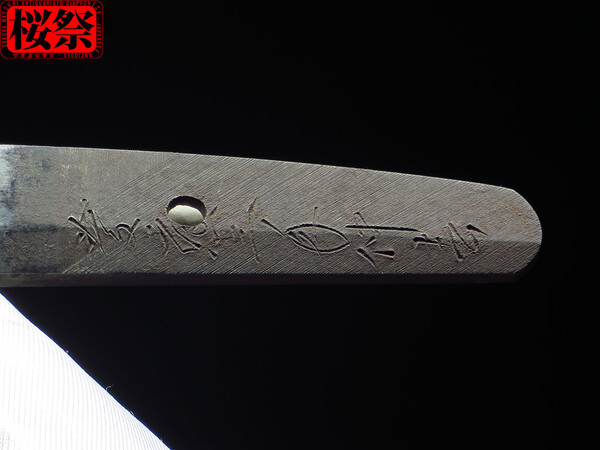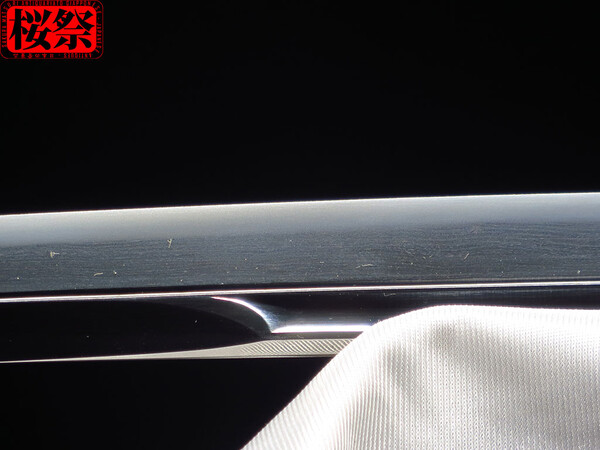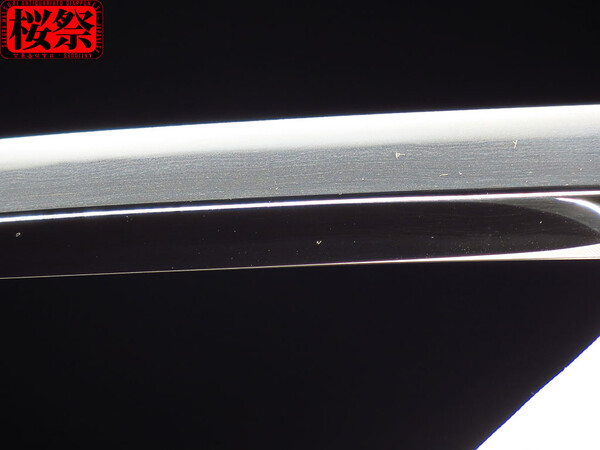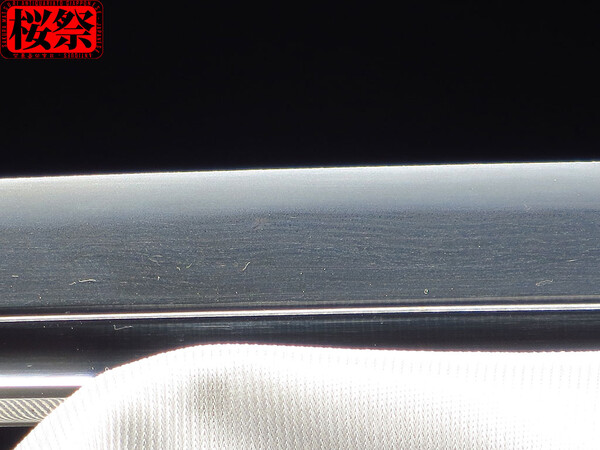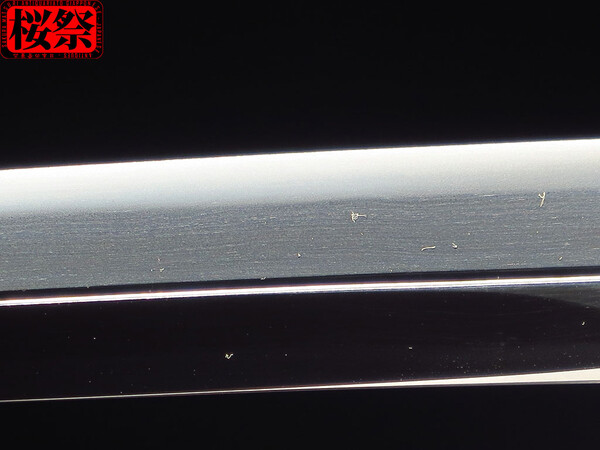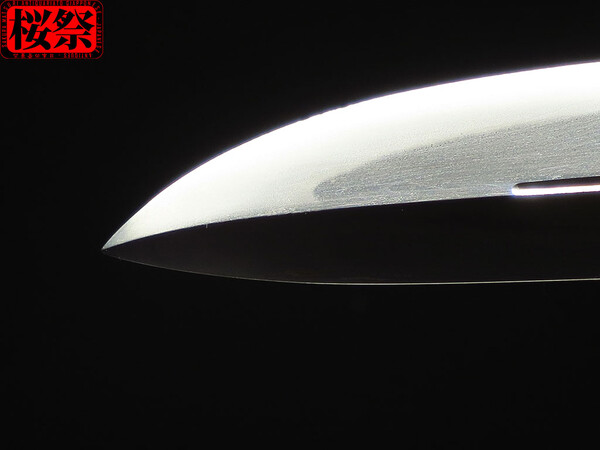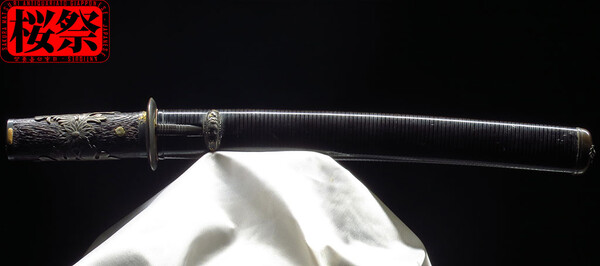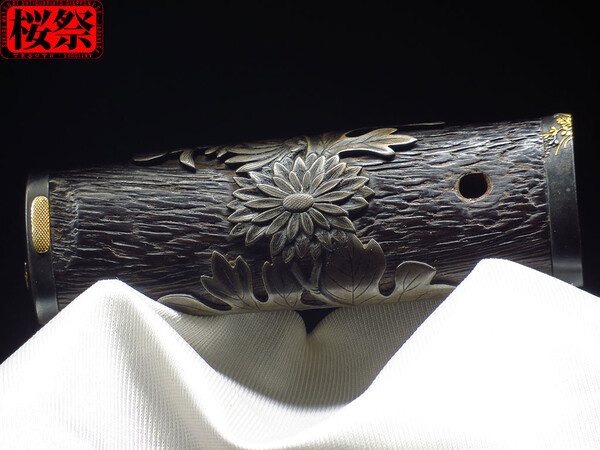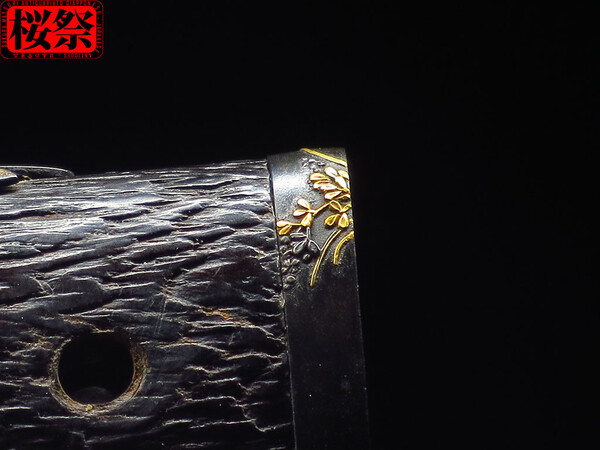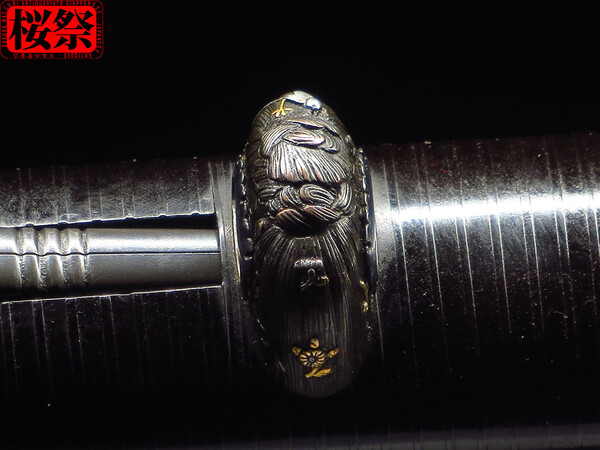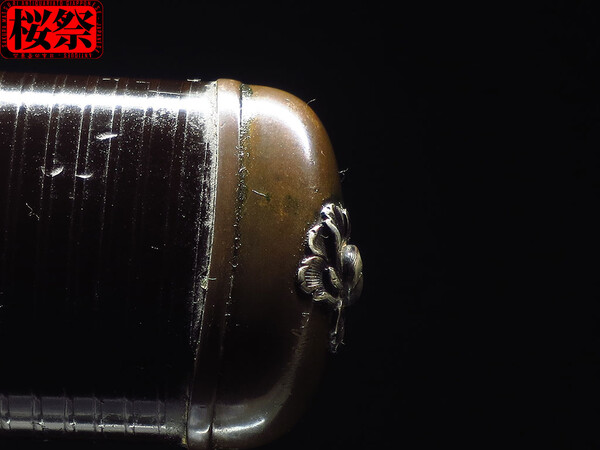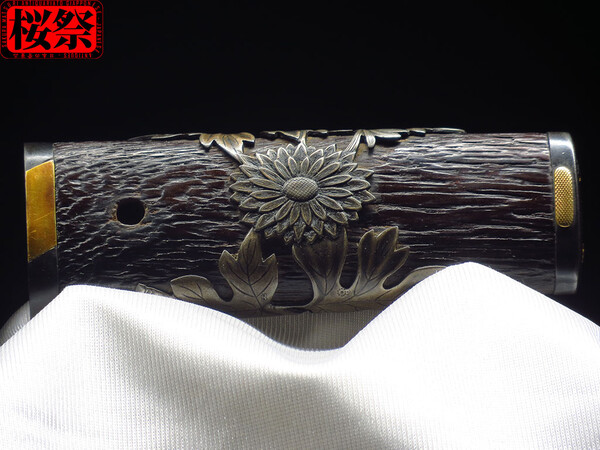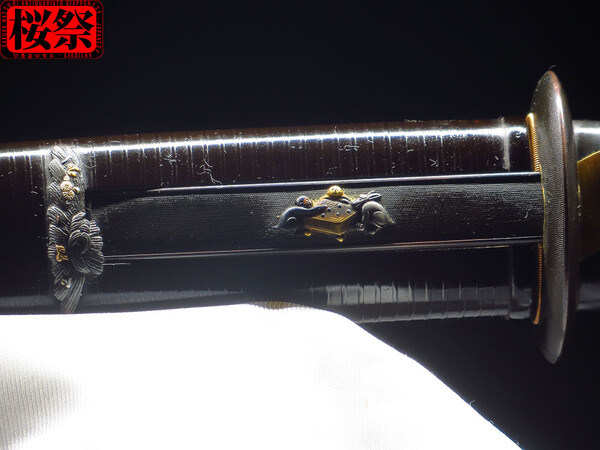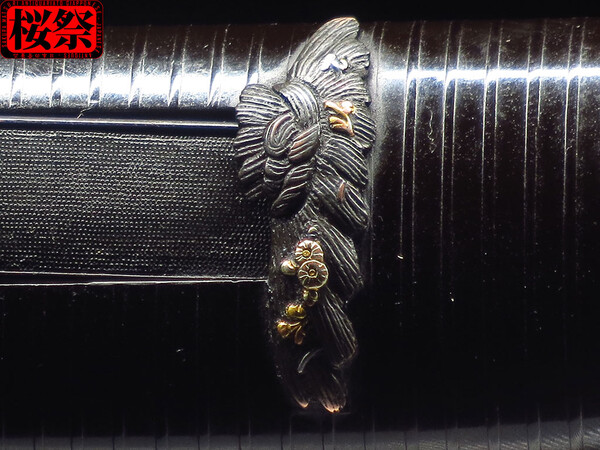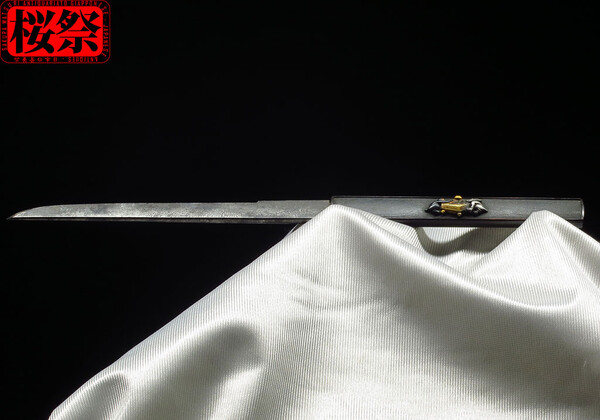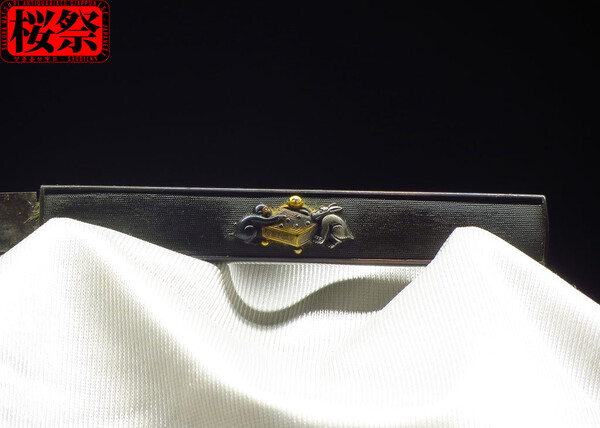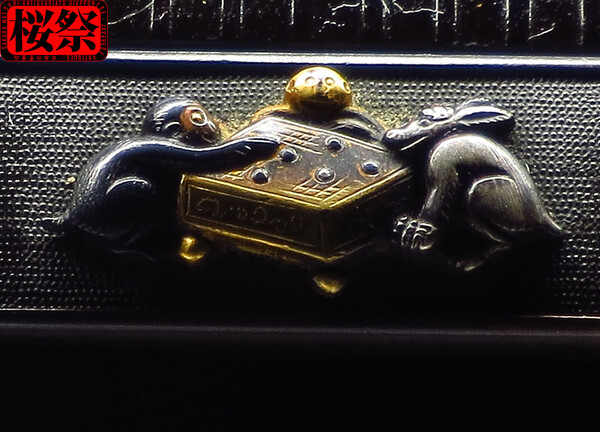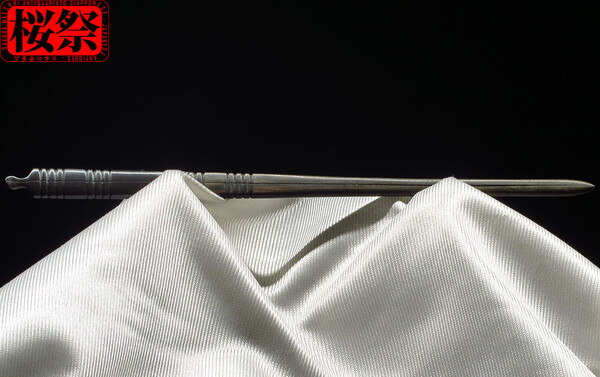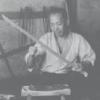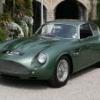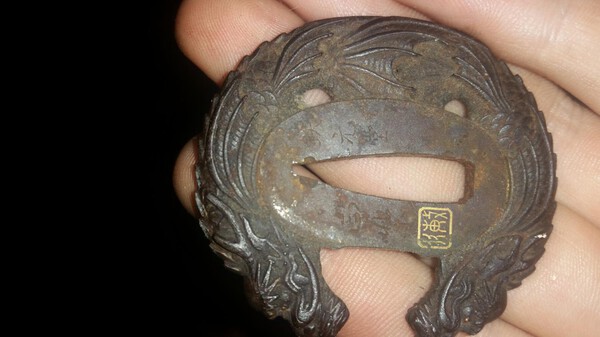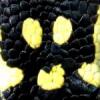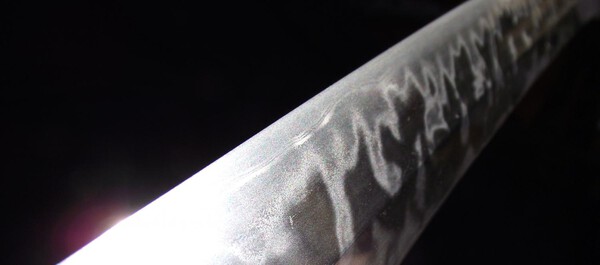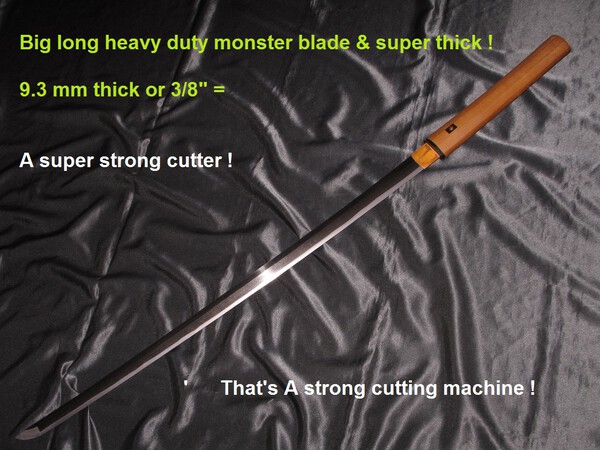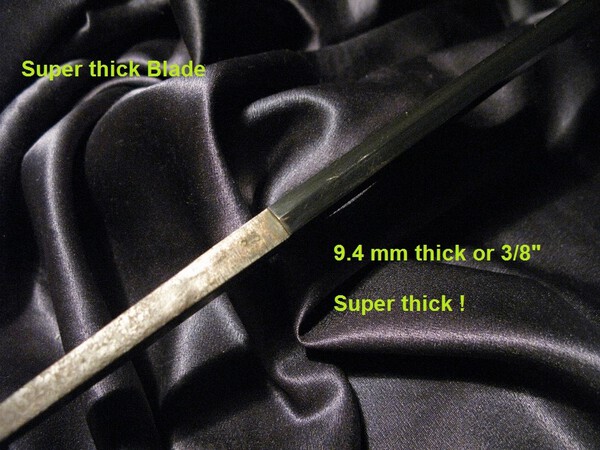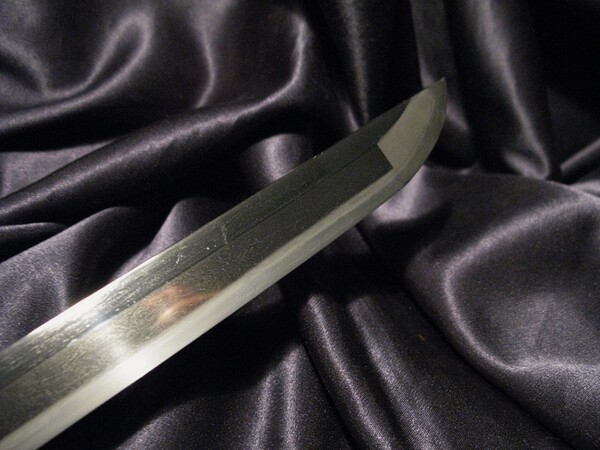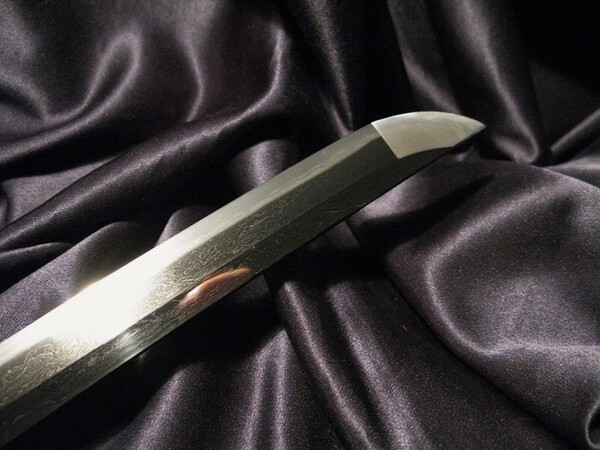Search the Community
Showing results for tags 'shin-shinto'.
-
Hello all. I bought this tanto a few months ago. I did not note down what the seller provided as the mei translation. I recall it was translated to "Miyamoto Kanenori". I was doing some research on this smith some time ago after I bought this, I read through a number of threads on here. Kanenori had a very interesting life as a smith, and is considered to be one of the best. This is why I believe this tanto is likely gimei if signed as that particular smith. I apologize for the photos, I found it difficult to take photos of this blade. I would appreciate your thoughts on Miyamoto Kanenori and this blade.
- 3 replies
-
- tanto
- translation
-
(and 1 more)
Tagged with:
-
Hey guys, Been a while since I've posted a new acquisition, but this one has me excited and its not something you see every day. I acquired it at the recent Chicago show and got it in a trade deal. I've put it in front of several people at the show, including Bob Benson. He seemed to really like it and told me how he could properly bring out the hada even more than it is already so this one is going to Bob for work eventually. His opinion was that it was late Shinto/Shinshinto. Bob did note that someone had messed with the nakago in an attempt to make it look older but he believes it would be easy to remedy and properly repatinate. It is a massive 29" nagasa with a VERY active hamon and mokume hada. There is kinsuji, inazuma, nie and nioe present. This piece feels like it was made to show off the smith's skills yet is mumei which leads me to believe that this was a temple offering piece. I am welcome to opinions on school and smith. My blind guess is perhaps Mino, but ken are so poorly researched that it is really anyone's guess. Without further ado, here you all go! (If you want to see it in person, DM me and I'll get you the information for the next ITK meeting which is this next Saturday.) The first picture shows my two other ken for reference to scale since I neglected to lay a tape down with it. The top one is a Yamato den, and the bottom is Bungo Yukihira (1199-1206).
-
Posting this somewhat in reference to an earlier post where I had meant to add additional context and images, but a vacation lead to me losing track of time. Here is my O-katana. It’s an aggressive shinshinto piece, signed Fujiwara Kiyondo and dated 8th month Bunkyū 2. The sword is not papered and the mei is not proven, this blade was discovered in poor condition gunto koshirae at an estate sale. It measures 38.25 inches overall with a 29.2” nagasa. Width of 1.4” at hamachi and 0.88” at yokote, though the yokote is obscured. I believe, based on the placement of the mekugi-ana and other clear indicators that the nakago is not ubu (though I am an amateur). There is around 2cm of ububa on the blade. What little of the hamon is visible is quite pleasing to the eye and I am queued with a few togishi. I am more interested than anything in polish for study and preservation of the sword, which seems to have lived a somewhat difficult life.
-
I have this small Shin-Shinto tanto I was planning to have a koshirae assembled for it. Here are some photos of the tanto in shirasaya and the handle (tsuka). I picked up this handle today as a birthday gift. I took these photos with my iPhone. I am looking for a tanto sized tsuba that will keep with or be appropriate for the theme of the handle. The menuki are of a tiger in bamboo. I think it would take me some time to find a good matching tanto tsuba. I am not in a big hurry anyways as I just purchased the tsuka.. Feel free to ask questions and discuss politely.
- 13 replies
-
- 5
-

-

-
- tanto
- shin-shinto
-
(and 1 more)
Tagged with:
-
Hello all, for my second post on NMB I’ll post my first sword, with a story and a question. A few years ago at an estate sale I stumbled upon a katana in very messed up gunto koshirae leaning against the wall of a shed. It was basically just the wood of the tsuka, two seppa and the metal saya. My grandmother’s maternal grandfather was a hatamoto, lineage of which she is quite proud, and she taught me various bits of what to look for and to do if I encountered nihonto. The sword is longer than the typical gunto with around a 29” nagasa, the nakago is signed Fujiwara Kiyondo, dated 1863. I left with it for pennies on the dollar, even at out-of-polish nihonto prices and had a shirasaya and habaki made for it immediately. I’ve attached some images below. It has spots of rust throughout, there are many small nicks in the cutting edge and the ububa remains. It has a magnificent o-kissaki, a somewhat shallow sori, and hints of an active suguha hamon are present. I understand that Kiyondo is a somewhat big name (excellent smith, student of Kiyomaro, etc.) and as such, am treating this sword as gimei until otherwise advised. My questions are, in this current condition, is polish feasible or is it too far gone? If polish is possible, (while my inclination is to do so,) would you pay the steep cost for what are basically entirely sentimental reasons? Finally, who are the better togishi in the greater United States area?
- 13 replies
-
- 1
-

-
- katana
- shin-shinto
-
(and 1 more)
Tagged with:
-
What characteristics besides the existence of showato and mass produced swords separate gendaito from Shinshinto? Basically, geometry wise, what makes these two different?
-
Hello again, I'm still on a gunto detour and would appreciate any thoughts others have on this sword I grabbed from our forum and would especially value ideas regarding what schools it might be tied to: It's seems to be another civilian sword converted to gunto use, hence the simple haikan and leather cover combined with the a civilian tsuba and other parts. I'm quite sure the blade is Shinshinto as it is fairly large and has little taper or curvature, and the nakago is also large and has patina somewhere between the thin growth on gendai and thicker growth on a Shinto era. Also doesn't have masame on the shinogi like the modal shinto. The sword's proportions are a nagasa of 70.5cm, Motohaba of 3.1 and Sakihaba of 2.3, which also seem within the shinshinto norm. Like the nakago, the kisaki is also bigger than the kanbun examples I've held. The first thing that struck me is the fittings on this sword are pretty nice: gold foiled habaki, shakudo fuchi, old iron ken menuki and a tsuba that seems to be made of wrought iron with copper alloy inlays above, rim is silver-grey and some scratches on it look silver so might be shibuichi. Makes me think the owner was pretty fond of it. Second was of course that it was a shinshinto and seemed to have a lot of patches of hardened steel on the ji and mune, most of the blade is out of polish hindering study but the the monouchi more or less is in polish and from studying the hardened spots there I can see they're composed of very dense amounts of nie that are at also acompanied by nioi like white clouds, in fact, the clouds in the densest area (just before the kisaki) look a lot like an extension of the hamon. I hope the photos I took show what I mean. There are a lot of rust spots and scratches in the tsubamoto so please focus on the monouchi to see the tobiyaki/muneyaki I've been pouring over Markus Sesko's Shinshinto-shi and other reference books to try and get an idea of what school the smith might have been trained by but so far have no solid suspect(or at least not one I'm brave/convinced enough to stick my neck out for). Apart from the hardening other possible Kantei traits I can see are the yakidashi, the gunome midare hamon that does gunome in salvos of three, the boshi with marked turnback and some hakikake, and osujikai with kesho for the nakago. It's worth mentioning the hamon has konie (although because the poor polish they're easiest to see in the monouchi) and right before the kisaki there is a lot of terminal widening of the hamon. Given how much hardening exists outside the hamon I wonder if it would be right to call this Hitatsura? I'd be happy for any thoughts or a suggestion on which page to focus on in Shinshinto-shi. Thanks
-
I came across this on Ebay-Netherlands and thought it might be worth posting. A small engraving on the nakago. The following is copied from the items description...... "The image/symbol on the tang is ENGRAVED and NOT stamped into the metal. I am told that the figure engraved into the Tang is one of the seven gods of Japan. I am told it is the "Happy Buddah" and I've also been told it is of the god "Daikoku", or "Daikokuten", one of the seven Gods of good luck/fortune-for agriculture, farmers, and wealth. I have shown this blade to several acknowledged "experts"-all of whom want the blade but none of whom would/could tell me "specifics." " Never seen anything like that myself and thought it may be better under this thread than a new one....but relocate if you wish. For interest @Bruce Pennington Rob
-
Hello NMB members I have for sale a stunning long and thick late Edo Katana in great condition/polish. I believe it to be the work of a Gassan sword smith by the name of Kensaishi Sadahru active between 1866-1868. It does come with a judgement paper from Japan but it is not at the rankings of the famous NBTHK-NTHK. On another note do I believe that they came to this conclusion at random absolutely not. I have 5 reason why I strongly believe it to be the work of a Gassan swordsmith 1. Tight masame hada 2.long nagasa that is over 28inchs long 3.gunome hamon 4.bo-hi accompanied by soe-hi 5.gentle curvature These are all features that can be attributed to the famous Gassan school of the late Edo period. All that aside I do not have it priced as a Gassan sword I have it priced as a gorgeous long Nihonto in really good condition with a beautiful koshirae Has a few extremely light scratches missing the mekugi peg and that is it. Boshi is intact everything fits as it should it's definitely the complete package for half the price of a NBTHK Gassan katana. 5100$ or best offer. Sincerely Edward.
-
Hello all, longtime reader, first time poster! I have here a kozuka I recently acquired with some shinshinto koshirae accompanying a pair of tanto. I am inexperienced with kozuka/kogatana, and any insight and/or translation assistance for this one would be greatly appreciated.
- 4 replies
-
- translation
- shin-shinto
-
(and 1 more)
Tagged with:
-
Dear all, I am looking for a Japanese sword in good condition (with its original dimensions, thus not over polished) from the Bakumatsu period along with its original koshirae. I need a textbook example, that is to say that the nakago must be quite long (well over 20 cm) and the nagasa must be over 75 cm. The sword must be signed and dated between 1854 and 1864. I am not looking for a specific or well known swordsmith, just an average to good one. The sword I am looking for must have been made for real combat. Usually, those swords are found with a shallow sori can be quite heavy and rather clumsy to yield, nevertheless, some are quite elegant (both type welcomed). If you have one for sale, please contact me by PM.
-
Dear all, I am looking for any information and oshigata of a bakumatsu swordsmith whose name was NOBUREN 信 蓮 who was active in the Bunkyu era (1861-1864) in the settsu province (Osaka). I only found this swordmith referenced on the NIHONTO CLUB site and it is also referenced on the HAWLEY as NOB413. He was used to sign as follow : 浪花金城辺岩井源徴司信蓮作之 : naniwa kinjō-hen iwai genkanshi noburen saku kore If you can help me on this one, I will really appreciate.
-
Was doing some photographs of a new tantō early this week that turned out nice. You can really see the actively call (imozuru 芋蔓) literally meaning 'potato vine' in and around the hamon as horizontal dark lines. This is a characteristic feature is seen in Shinto and Shinshinto works of Satsuma Province. Also attached is the overall view of the small tantō. I am getting Markus Sesko to help me with the signature which I have posted about earlier. Enjoy and politely discuss.
-
I have this new shinshintō tantō that picked up at the Tampa show last weekend. I think the nakago read 'Sashū Mikawa Tensaido'. The reading of the signature is based upon the previous owners notes. The tantō is also dated on the reverse side. Please note I am a professional Japanese fine art and antiques dealer and have studied Japanese language myself. I often don't need help with these type of things but i can't find any information about this swordsmith. I will at some point down the line use this information to help sell the Tantō.
-
Hi, have a Wak which might have been used by a person working for the goverment, due to Koshirae. Blade is mumei with a very special Hamon. Anyone recognise region, potential smith/smiths? Was thinking about Mino due to Hamon but I am not that experienced in this thing. Blade lenght 31.3 cm Any help will be appreciated. Thanks in advance, Krister
-
New to me and bought at the weekend. A very robust blade and spec's on the photo's. What intrigues me on this heavy blade, 7 mill. thick at the mune base and weighing 600 grms, is that it has two mekugi-ana, but looks to be Ubu. Sadly scrubbed at some point, including the nakago.. A more knowledgeable friend hazarded a guess as it being Mino and dating to the 1720's. Thoughts please.
-
Gassan Sadakazu tanto, with Bakumatsu style koshirae, with fittings by Shoami Masamitsu. Double Tokubetsu Kicho certification, one for the blade and one for the koshirae Age: Shinshinto, Edo Jidai, Bakumatsu Nagasa: 27,4cm Sori: 0,3cm Moto-haba: 2,8cm Saki-haba: 2,0cm Moto-kasane: 0,7cm Saki-kasane: 0,5cm Mei: 月山貞一造 - Gassan Sadakazu tsukuru (Kao) and commission Certificates: koshirae (Tokubetsu Kicho, 04/05/1970, specially precious item), Tanto (Tokubetsu Kicho, 5/4/1970, specially precious item). Description: Shinshinto period tantou signed Gassan Sadakazu, mounted in typical Bakumatsu koshirae. U no kubi zukuri sugata, powerful masame hada with scattered sparkling nie, suguha hotsure hamon that lead to an average kaeri boshi. This tantou is among Sadakazu's first period blades, Yamato style. Most important the presence of the commission inscribed on the tang, indicating the highest quality level. This blade's nakago is signed with Gassan Sadakazu tsukuru mei , owl's kao with sada character inside and commission. Koshirae is of highest level, typical of Bakumatsu period, with kodogu made of shakudo, shibuichi, gold and silver. Details are incredibly fine made by master Shoami Masamitsu, which signature with kao in inscribed on the back of kozuka. Every kodogu is of the highest level, from tsuba's pitting to kojiri's peony, from details on fuchi and kashira to the scene depicted on kozuka where a monkey, a rabbit and a frog are sitted around the go table. The kogatana is signed 日本鍛冶宗匠雷除伊賀守藤原金道 - nihon kaji sōsho raijo iga no kami fujiwara kinmichi (wazamono), 2nd generation, Kan'ei period 1624-1644, which real name was Mishina Kanbei; on the blade is inscibed a chrisantemum. The hada is itame mixed with masame, while hamon is gunome midare. The tsunagi is skillfully crafted, with detachable habaki made of magnolia. Gassan Sadakazu is ranked JoJoSaku and both certificates are of Tokubetsu Kicho level. Since this is my first item here the price is €8900 + shipping
-
All, I am selling a sword by one of the better shinshinto smiths, Miyaguchi Ikkansai Shigetoshi. He was one of Kasama Shigetsugu's teachers and is discussed at length in Chris Bowen's article, "The Forgotten Craftsmen: Swordsmiths of the Meiji and Taisho Eras" (found here). The sword comes in shirasaya and is accompanied by pristine shingunto mounts and would make a nice addition to the nihonto and military sword collector. About the Sword: Mei: Bu-un chōkyū (Eternal luck in war) Ikkansai Shigetoshi Nengo: Meiji 36 nen 8 gatsu hi, 66 okinasaku (Made in August 1903, when Shigetoshi was 66 years of age) Habaki : Copper single foiled Habaki Blade length : 63.5 cm or 25 inches. Sori : 1.4 cm or 0.55 inches. Mekugi : 2 Width at the hamachi : 3.24 cm or 1.27 inches. Width at the Kissaki : 2.40 cm or 0.94 inches. Kasane : 0.7 cm or 0.27 inches. Era : Meiji (1903) Jitetsu : Koitame hadawell grained with JInie attahce, Fine Chikei work is appearing and most Jigane. Hamon : Nie deki suguha with mixture of Ko-NOtare mixed. There is KOashi appearing in the ha. Boshi is round ended. I will offer a 3 day inspection period as well as a 12 month shinsa guarantee (NBTHK or NTHK). As always a donation will be made to the NMB. Price: $5,000 OBO About the Smith (From the Sesko Index): "Shigetoshi (繁寿), Keiō (慶応, 1865-1868), Suruga – „Ikkansai Shigetoshi“ (一貫斎繁寿), „Sunpu ni oite Miyaguchi Ikkansai Shigetoshi“ (於駿府宮口一貫斎繁寿), „Sunpu-jū Ikkansai Shigetoshi“ (駿府住一貫斎繁寿), civilian name „Miyaguchi Hachirō“ (宮口八郎), he was born in the ninth year of Tenpō (天保, 1838) in Shizuoka in Suruga province but went later to Inaba where he was first a student and later the adopted son of Hamabe Toshinori (浜部寿格), but he later returned to Shizuoka and to his family name „Miyaguchi“, in Inaba he signed with „Hisatoshi“ (寿俊), later he adopted the gō „Ikkansai“ (一貫斎) and also signed with „Shigehiro“ (繁広), he worked in Sagami´s Odawara (小田原) too, transmission says that he learned the art of horimono carving at the lineage of Ozaki Suketaka (尾崎助隆), he died January 25th 1906 at the age of 69, dense itame, chōji-midare in nioi-deki or gunome-midare in ko-nie-deki"
-
Hi all. I've had a sword floating around the house for a while and the other day I decided to try and do some research on it. According to a member on another forum (Reddit), it's an antique Japanese tanto from the shinshinto period. I took it apart to take some pictures of the tang, and there were quite a few markings on the tsuba that I was hoping you guys might be able to help decode. There were no markings on the tang, so I'm hoping that the tsuba might be able to tell me a little more about the history of the sword. I know that the fittings were changed pretty often, but this would at least give me a jumping off point. I only have a few pictures of it, but they should be clear enough to read the writing and see the design. I can provide more pictures if needed. Thanks in advance for your help. Since one of my pictures is more than halfway to the file size limit, here's a link to an album I made with a bunch of pictures of the sword. http://imgur.com/a/WzV2m
-
After some consideration and a large amount of emails/phone calls regarding my participation on here it has become apparent that a little perspective on my thoughts of the future of Nihonto as an art form (shinsakuto) and what I feel may seriously affect its continued survival especially outside of Japan. Disclaimer: this is just an opinion based on my observations so chances are some might disagree. Working outside of Japan as a craftsman means that I see more oddities and questionable swords on a regular basis than most, some are obviously not Nihonto and some just leave us stumped. While it would be ideal to just see true quality Nihonto all the time the truth is outside of Japan it isnt always going to be likely . Instead I on a daily basis get emails with very unresearched questions and often aggressive attitudes with pictures of all sorts. . . I have also learnt that there are no definites only educated guesses. . . not every odd looking blade is a "chinese fake"! So by default I can now recognise the fakes etc relatively easy but no I dont know much on the paul chen, hanwei or what ever brand of who made what, when etc. . . . just not my thing I am however seeing some impressive fakes and they are only going to get better. . . and I would prefer to be on the top of the game. Now if you collect Koto blades chances are you are not going to have to worry to much about said issue but Gendai or even shinshinto then could be an issue as for shinsakuto . . most definately It seems (going by memory of past threads) that this topic stirs a lot of emotions and the kind gentle folk sometimes become obnoxious bakemono . The problem is real and it is not going away so without civil discussion and shared information it will continue its cancerous spread through the gates of ignorance (i should stop watching "the Tick"). I like many others like quality shinsakuto (maybe its all those years bladesmithing) they, if nurtured will one day become historical art pieces. . . I for one would hope that I have facilitated in that journey during my time in this hobby. Just some thoughts to ponder so please be nice. . I have the Flu Kam One of my favourite Shinsakuto. . probably the best example from Hidehisa
- 9 replies
-
- 2
-

-
- gendaito
- shin-shinto
-
(and 1 more)
Tagged with:
-
Hello guys, some time ago i came across this term and wondered about the meaning. I think the term loyalist blade describes a certain type of blade in terms of the dimensions (heavy kasane, slightly or even significantly longer than standard) and it had to be produced in a quite narrow time period (shin-shinto period,1860´s). But i could not really find any further explanation, for example which group started to wear them first (Sonno-joi)? Was it a political statement or just something to annoy the establishment? This is a katana of my collection. It has a kasane of 9,3mm and a nagasa of 75,3cm. It was forged around the 1860`s and therefore i think that it is quite a standard example of this type. Any comments are welcome Regards,


